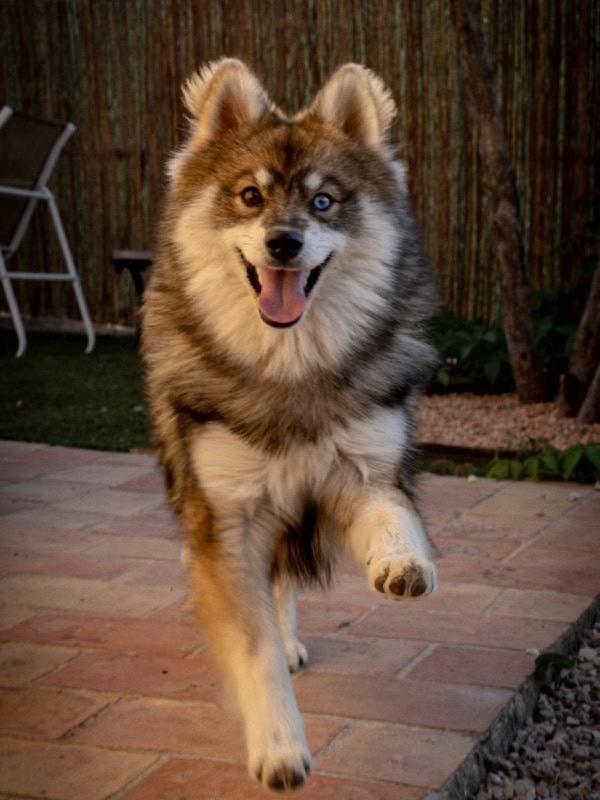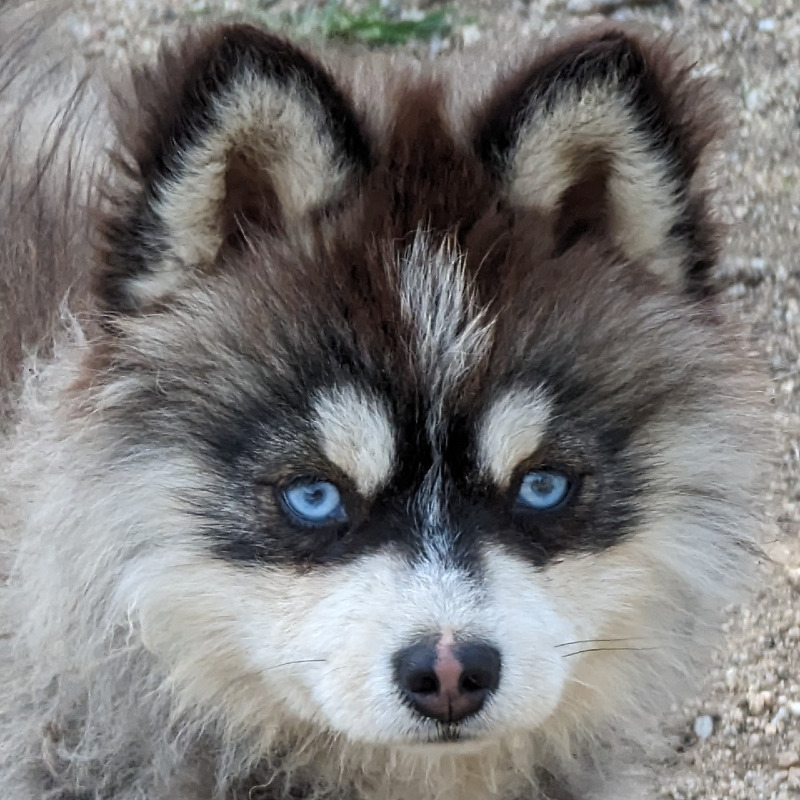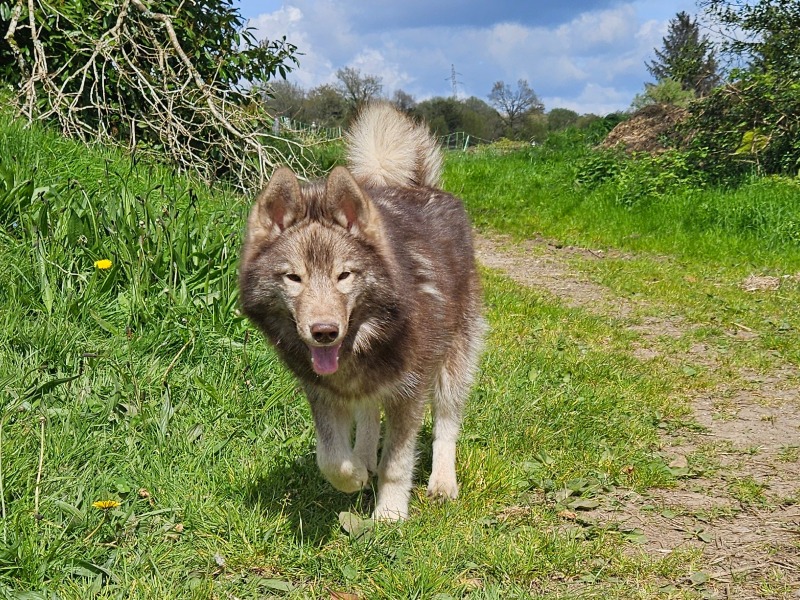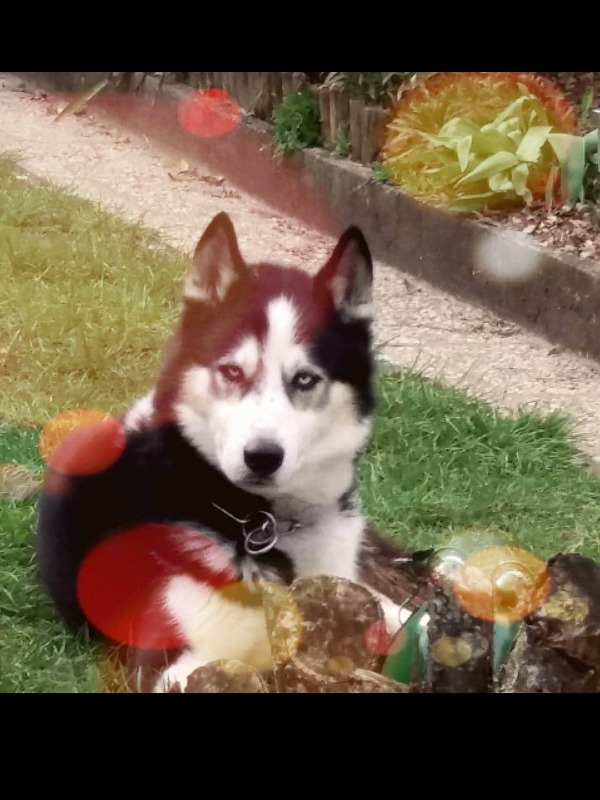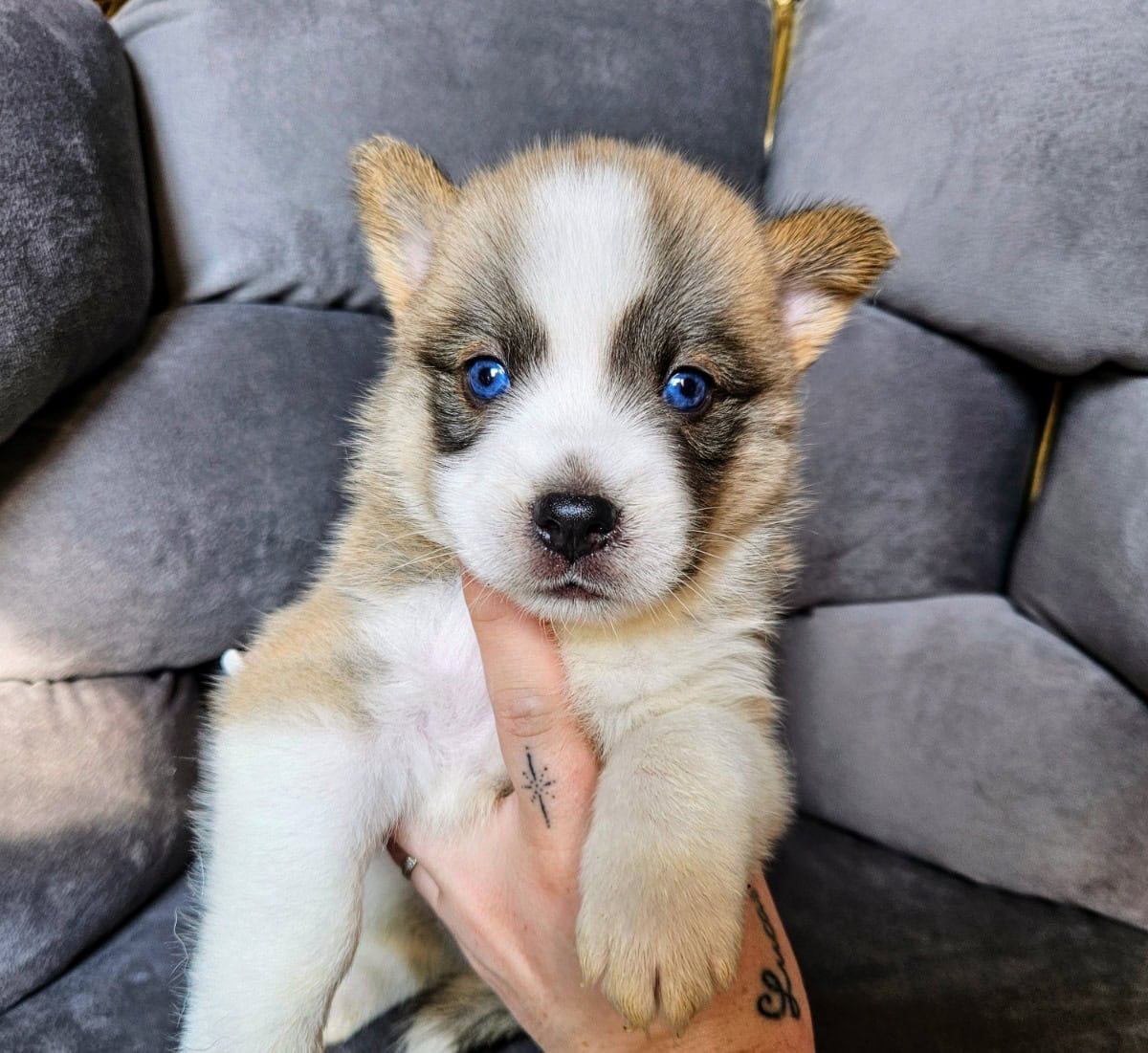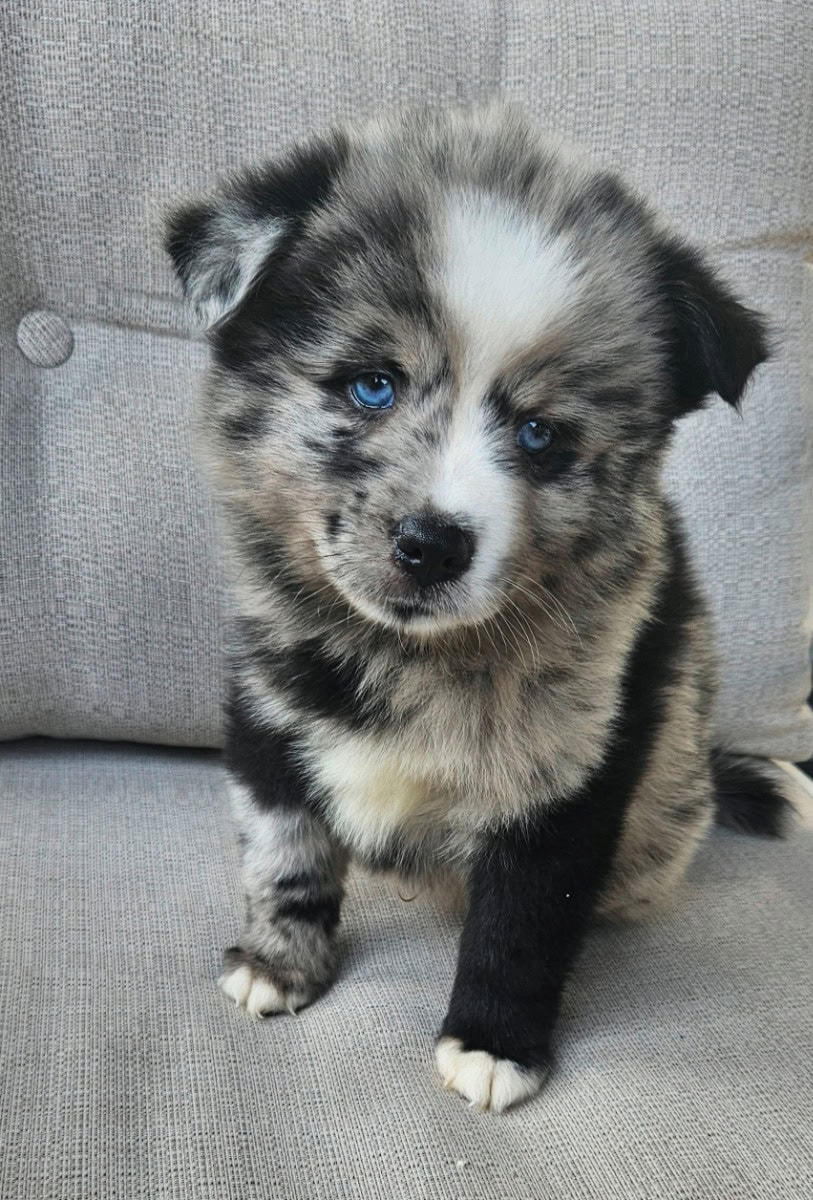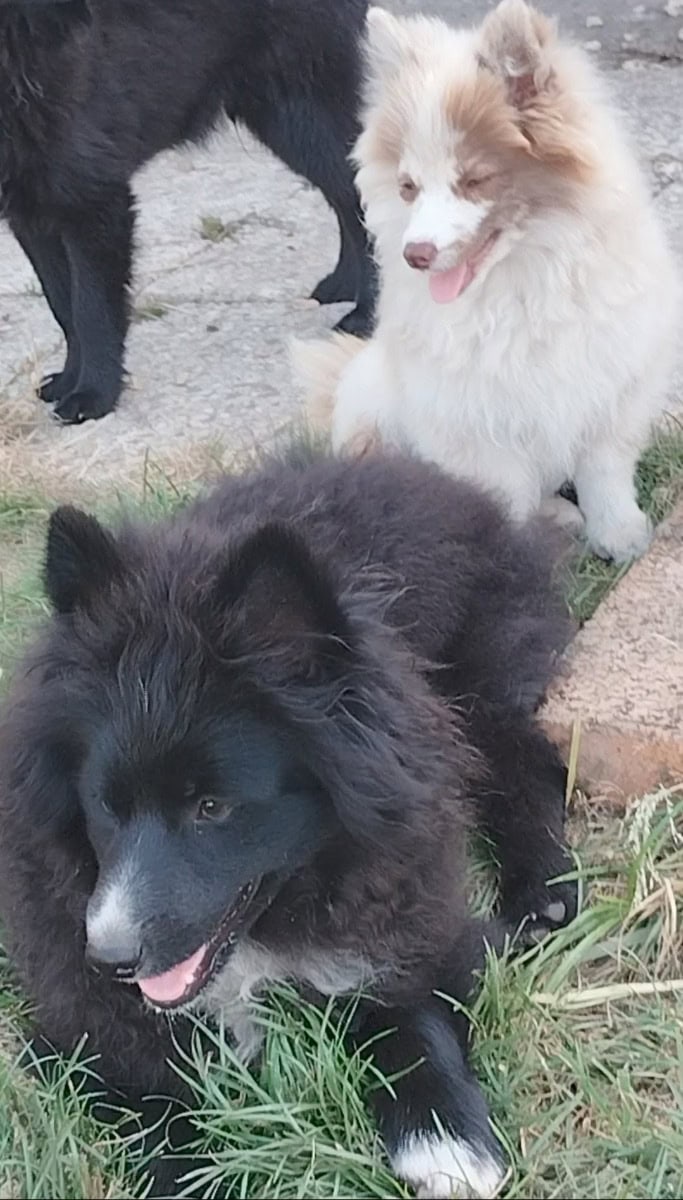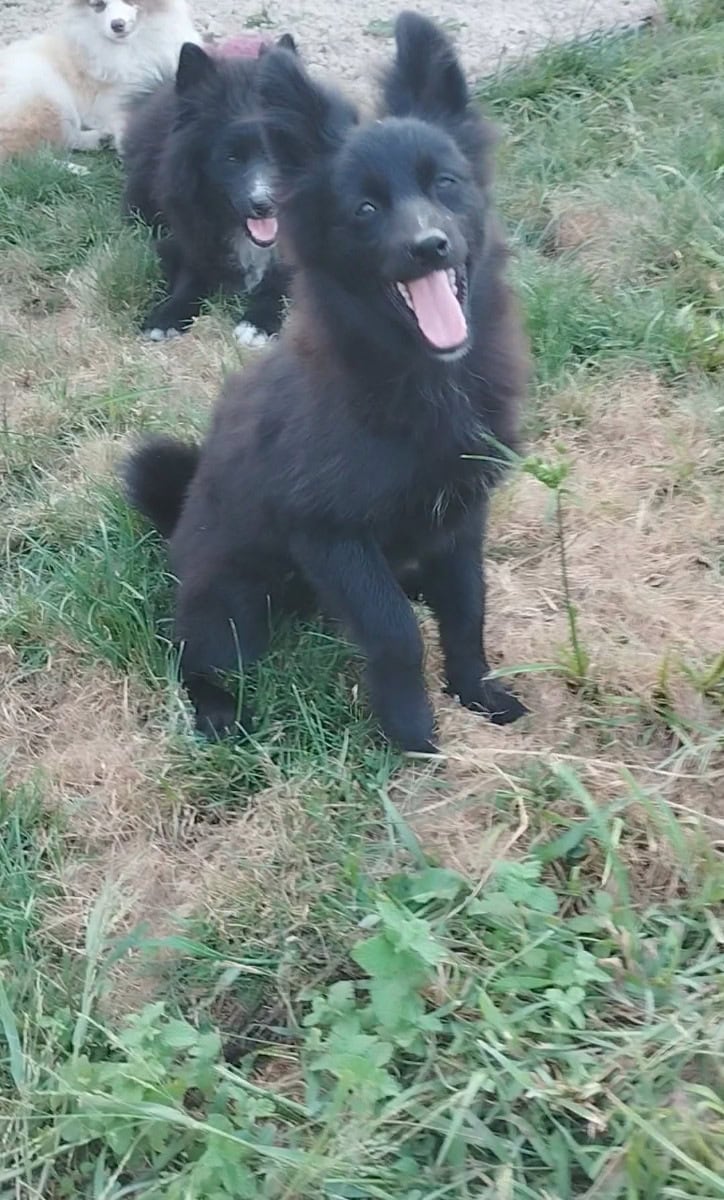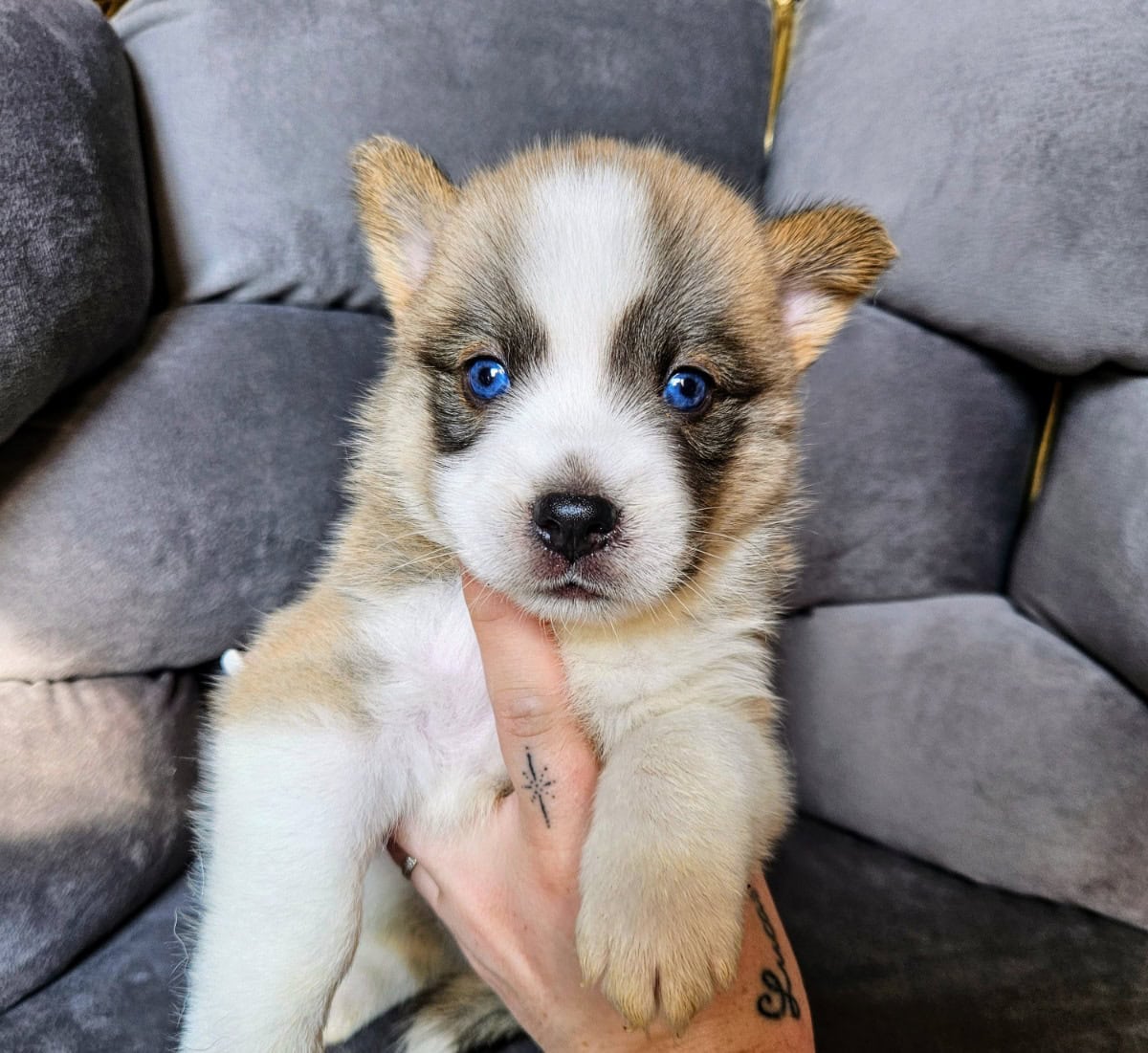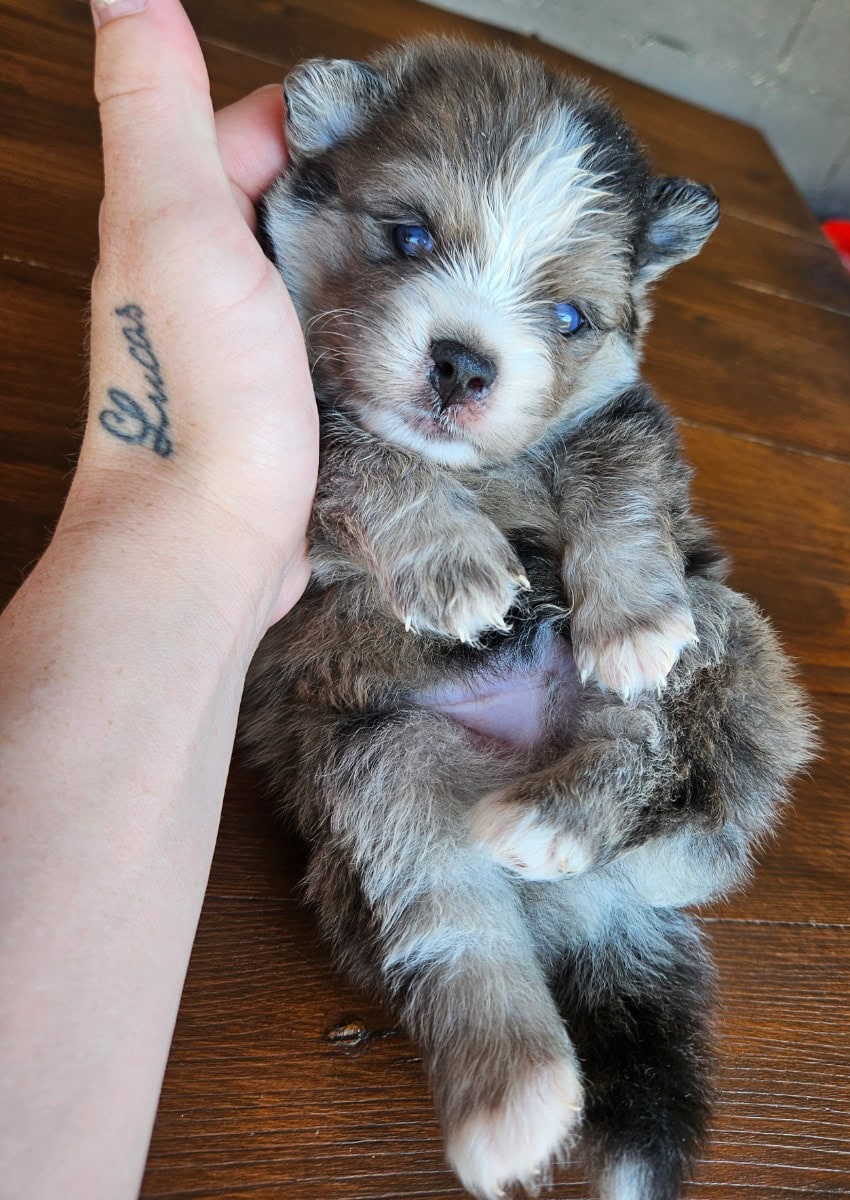Pomsky
Discover the Pomsky, a dog with a captivating appearance, resulting from the cross between a Siberian Husky and a Pomeranian. Affectionate, energetic, and intelligent, it will charm families with its charisma and dynamic personality. Adopt a Pomsky for a canine adventure filled with joy and companionship!
Awareness of acquiring an animal
Adopting or breeding a dog is a responsibility that must be carefully considered. Dogs are loyal companions that require time, attention, and constant care. Whether for leisure, passion, or professional breeding, it is crucial to understand the specific needs of each breed. Provide them with a loving and stimulating environment, and avoid any impulsive acquisition that could harm their well-being. Be a vigilant and committed owner for a happy and healthy companion.
To learn more about animal welfare, we invite you to consult our FAQ by clicking the button below:
Origins and history
The Pomsky is a relatively recent dog breed, resulting from the cross between a Siberian Husky and a small breed dog, primarily the Pomeranian. This combination aims to create a dog that has the appearance of a husky while being smaller in size. The first Pomskies began to appear around the year 2010, reflecting a growing trend towards hybrid dog breeds.
The breeding of Pomskies has gained popularity due to their attractive appearance, often characterized by very expressive eyes, thick fur, and features resembling those of the husky. Breeders typically select parents with friendly temperaments to promote desirable behavioral traits in the puppies. However, this hybrid breed is also the subject of debate, particularly regarding breeding conditions and the health of the animals.
As a result, it is essential for prospective Pomsky owners to research reputable breeders who adhere to ethical breeding standards. A good breeder will care about the health and well-being of the animals, thus avoiding issues related to inbreeding. The popularity of this breed continues to rise, attracting dog enthusiasts who seek a companion that is both beautiful and friendly.
Physical characteristics
The pomsky is a dog that attracts attention with its charming appearance and distinctive physical traits. This crossbreed between a husky and a Pomeranian is characterized by a thick and dense coat, often marked by appealing patterns. The texture of its fur can vary, ranging from soft fluff to longer, silky hair, and it is generally available in a wide range of colors, including black, gray, brown, and white.
In terms of size, the pomsky is considered a medium to small dog, typically measuring between 30 and 50 centimeters at the shoulder. Its weight can vary from 7 to 15 kilograms, making it an easy-to-manage companion. Its head is often wedge-shaped, with erect ears that add to its little wolf-like appearance. The eyes, which can be almond-shaped, are often very expressive and can range from blue to brown, sometimes even having one eye of each color.
The pomsky has a curled tail that adds a touch of dynamism to its appearance. Its gait is energetic, reflecting its heritage as a working animal. Overall, the pomsky combines the appealing traits of its parent breeds, creating a dog with both an elegant and robust physique that is popular among many dog enthusiasts.
Character
The Pomsky is a dog breed that attracts many enthusiasts due to its charming appearance and unique personality traits. This crossbreed between a Husky and a small Spitz-type dog offers a variety of temperaments, but certain character traits are frequently found in these animals.
First of all, the Pomsky is generally very intelligent. This trait makes it easy to train, but it can also lead to a certain independence. This need for independence can sometimes make training challenging, as these dogs often seek to explore on their own. Mental stimulation and regular exercise are therefore essential to prevent boredom, which can lead to destructive behaviors.
Additionally, the Pomsky is often described as very sociable and affectionate. It tends to bond strongly with its human family and seeks attention. This need for interaction makes it an excellent companion for active individuals and families. However, this sociability also means that it can be reactive towards other animals and strangers, requiring early socialization.
Finally, the Pomsky's boundless energy makes it a dog that needs a lot of exercise. Daily walks, active play, and stimulating activities are essential for its physical and mental well-being. The Pomsky can become a wonderful adventure companion, as long as it receives the attention and care needed to thrive.
Life expectancy
The life expectancy of a Pomsky typically ranges between 12 and 15 years. This longevity is relatively higher than that of some other dog breeds, which attracts many prospective owners. As with all breeds, several factors influence this life expectancy, including genetics, lifestyle, and the care provided to the animal.
Regular veterinary care plays a crucial role in a Pomsky's health. Frequent visits allow for the quick detection and treatment of potential health issues. A balanced diet tailored to its needs, as well as sufficient physical exercise, also contribute to its overall well-being. Good socialization and mental stimulation are equally important, as they help prevent problematic behaviors.
It is also important to consider the predisposition of this breed to certain diseases. Like many mixed breeds, Pomskies can be prone to hereditary issues, including eye disorders or joint problems. By adopting a proactive approach in their breeding and choosing responsible breeders, one can improve the chances of a healthy and extended life.
Exercise and activity needs
The Pomsky is a hybrid breed resulting from the cross between a Husky and a Pomeranian. Due to its heritage, this breed has a high level of energy that requires a commitment to exercise and activity. Pomskies need at least one hour of physical activity each day. This can include walks, runs, or interactive games that encourage them to expend energy.
Games such as frisbee or tug-of-war are particularly beneficial for stimulating both their bodies and minds. Pomskies are also very intelligent and need mental challenges to avoid boredom. Puzzle games or obedience training can help satisfy this cognitive need. A lack of sufficient activity can lead to destructive behaviors as these dogs seek to release their pent-up energy.
In summary, Pomskies require a regular and varied exercise regimen for their physical and mental well-being. An active owner, capable of entertaining them and providing frequent outings, will be ideal for this dynamic and affectionate breed.
Recommended diet
The Pomsky is a hybrid dog that results from the crossbreeding of a Siberian Husky and a Spitz. With an active nature and a strong personality, its diet must meet its energy and health needs. It is crucial to choose high-quality kibble, specially formulated for medium to large breeds, that provides an optimal balance of proteins, fats, and nutrients.
Proteins are essential to support the Pomsky's muscle growth and vitality. It is recommended to select foods containing at least 20 to 30% protein from animal sources such as chicken, beef, or fish. Fats also play a key role in energy and skin and coat health, so it is important to ensure that the diet includes essential fatty acids, such as omega-3 and omega-6.
Additionally, special attention should be given to hydration. The Pomsky should always have access to fresh water. Treats can be offered in moderation, but they should not make up more than 10% of its daily caloric intake. Finally, it is advisable to divide meals into two or three portions per day to avoid digestive issues and maintain a healthy weight. By following these guidelines, you will help ensure the health and well-being of your four-legged companion.
Training and obedience
The Pomsky is a crossbreed between a Husky and a small dog, often a Spitz. Due to its heritage, this breed has an energetic and playful personality, which requires a specific approach to education and training. One of the keys to raising a well-balanced companion is to start training at a young age. Puppies are particularly receptive to learning, and early socialization helps them to get accustomed to various environments, people, and other animals.
The positive reinforcement method is especially effective for this breed. Rewarding good behaviors with treats or praise encourages learning. A patient and consistent approach is essential, as Pomskies can sometimes be stubborn. Using simple and clear commands facilitates their understanding.
It is also important to incorporate regular physical activities. These dogs need exercise to channel their energy and prevent destructive behaviors. Interactive games and daily walks contribute to their well-being. Finally, patience and consistency are crucial. With proper training, a Pomsky can become an exceptional, loyal, and well-balanced companion.
Behavior with children
The behavior of Pomsky dogs with children is generally positive, making them cherished companions for families. These mixed-breed dogs, a cross between a husky and a spitz, often display a friendly and playful nature. Their high energy and curiosity make them particularly appealing to young children, who can enjoy playtime together.
However, it is essential to note that each animal has a unique personality. Some Pomskies may be more reserved or shy, especially if they haven’t been adequately socialized from a young age. Early socialization and regular interactions with children can encourage adaptable and friendly behavior.
Parents should also teach children how to interact with dogs respectfully. Basic rules, such as avoiding sudden movements and knowing when to give the dog some space, are crucial for ensuring harmonious coexistence. A safe and supervised play environment, along with proper training, will help establish a positive relationship between Pomskies and children.
Compatibility with Other Animals
The pomsky, known for its attractive appearance and playful character, can be an ideal companion in a household with other pets. However, its compatibility largely depends on early socialization and training. Dogs of this breed tend to be friendly, but they also possess a hunting instinct inherited from their ancestors. Therefore, it is essential to gradually acclimate them to other animals, especially small mammals like rodents or cats.
Socialization from a young age plays a crucial role in their future behavior. Exposing the pomsky to different animals and situations is paramount. This will help them develop an understanding of other species and learn to interact with them appropriately. Consistent and positive conduct is recommended to reinforce good interactions.
Furthermore, the temperament of the pomsky can vary from one individual to another. Some may be more dominant, while others may be particularly docile. Monitoring their interactions is therefore essential, especially at the beginning. Careful control and supervised play will help establish a harmonious dynamic. Thus, with proper preparation and attentive care, the pomsky can successfully integrate into a multi-pet household, bringing joy and companionship to all.
Grooming needs
The Pomsky is a hybrid breed that requires regular maintenance to keep its health and appearance in good shape. First of all, grooming is essential. Due to their dense, double coat, these dogs shed a significant amount of fur, especially during shedding seasons in spring and fall. Weekly brushing is recommended to prevent tangles and reduce the amount of hair in the house. During shedding season, more frequent, even daily brushing may be necessary.
Additionally, it is imperative to monitor dental hygiene. Regular tooth brushing helps prevent periodontal disease, while treats designed for oral health can also be beneficial. Ears should be checked regularly for signs of infection, and gentle cleaning may be needed to avoid wax buildup.
Finally, bathing should only be done when necessary, to avoid disrupting the natural oils in their coat. With proper care, a Pomsky can remain both healthy and beautiful.
Health
The health of pomsky dogs, a cross between a husky and a spitz, deserves special attention. These hybrid dogs may exhibit various health issues inherited from their parents. The most common hereditary diseases include hip dysplasia, eye problems such as cataracts, and various dermatological disorders. Regular veterinary check-ups are essential.
Nutrition plays a key role in the health of this breed. A balanced diet, rich in nutrients and tailored to their activity level, helps prevent obesity, which is a risk factor for many diseases. It is recommended to choose high-quality kibble and avoid foods containing fillers.
Finally, exercise is essential. Pomskies need daily physical activity to stay healthy. Long walks, interactive games, and mental stimulation activities help mitigate the predisposition to behavioral and health problems. Therefore, providing a stimulating and active living environment is crucial to ensure their overall well-being.
Environment and habitat
The Pomsky is a hybrid dog resulting from the crossing of a Siberian Husky and a Pomeranian. As a relatively recent breed, it has distinct physical and behavioral characteristics. The environment in which a Pomsky lives must be adapted to its needs, as it is an energetic and intelligent animal.
Prioritizing a spacious living space is essential, especially due to their need for exercise. A secure garden allows this dog to play freely. However, an apartment can be suitable, provided that frequent walks and play sessions are included. Their natural curiosity and love for exploration require increased vigilance during outings, especially in unfamiliar environments.
In terms of climate, the Pomsky has a double coat that protects it against the cold. However, it is sensitive to high temperatures. In hot climates, it is crucial to ensure their well-being by avoiding long exposure to the sun. Therefore, it is vital to organize their habitat considering climate variations to ensure their comfort and health.
Name ideas
Choosing a name for a Pomsky is an important task that reflects the personality, appearance, and heritage of this unique dog. A good name should be easy to pronounce and remember, while avoiding sounds that are too similar to the commands you will use frequently. Think about physical characteristics, such as their silky coat and piercing eyes, or their playful and affectionate temperament.
It is also wise to select a name that has some history or meaning, whether it is a reference to culture, nature, or an element you are passionate about. Short and catchy names are often the most effective, as they make it easier for the dog to learn and recognize them.
Here are about fifteen name suggestions for a Pomsky: Zia, Neko, Miko, Luna, Zorro, Kyra, Scout, Koda, Suki, Rio, Sky, Pika, Ember, Juno, and Pixel. By choosing one of these names, you can perfectly capture the vibrant spirit of your canine companion while giving them a unique identity.
Average purchase price
The price of a purebred Pomsky can vary significantly due to several factors. Generally, one can expect to pay between 1,000 and 3,000 euros for a healthy puppy from a reputable breeder. Costs can be influenced by the breeder’s reputation, the puppy’s lineage, and market demand. Specimens with remarkable traits or from champion bloodlines can reach higher prices.
In addition to the initial purchase cost, it is essential to consider the long-term expenses associated with dog ownership. This includes costs for food, veterinary care, grooming, and necessary supplies. Dogs of this breed, needing regular exercise and mental stimulation, may also incur additional expenses for activities such as training or boarding.
Before purchasing a Pomsky, it is advisable to conduct thorough research on breeders and ensure the health and well-being of the animal. This ensures a positive experience for both the owner and the dog.
Expenses
Owning a Pomsky involves various monthly costs to consider. Generally, food expenses are a major part of the budget. For a medium-sized dog like the Pomsky, it is reasonable to budget between 50 and 90 euros per month, depending on the quality of the kibble chosen.
Veterinary care is also essential. A routine veterinary visit can cost between 30 and 60 euros per month, taking into account vaccinations, preventive treatments for parasites, and dental care. It is advisable to set aside a budget for emergencies, bringing this cost to about 20 euros monthly for proper follow-up.
Accessories, such as toys, leashes, and bedding, represent an additional expense. Budgeting around 20 to 30 euros per month allows for the replacement of these items as needed. Finally, grooming costs, if necessary, can add up, with expenses ranging between 30 and 50 euros per month, depending on the frequency and services chosen.
In summary, for a Pomsky, a reasonable total monthly budget falls between 150 and 230 euros, depending on the choices made regarding care and product quality.
Destination and usage
The Pomsky is a dog that combines charm and character, making it a highly appreciated companion for families and individuals. With an adorable appearance, it often draws attention with its coat and small size. These dogs are primarily pets, and their lively and friendly personality makes them ideal for family life. They easily adapt to different environments, whether it's an apartment in the city or a house with a garden.
The sociability of the Pomsky is one of its major strengths. It gets along well with children and other animals, making it a smart choice for those looking for a playful and affectionate companion. Their curious and energetic nature requires regular interaction and activities, such as walks or games, to keep them happy and stimulated. Additionally, these dogs are often described as intelligent, which makes it easier to train them and teach them new tricks.
In summary, the Pomsky is an excellent option for those seeking a loyal and dynamic pet. Whether it's to share moments of play or moments of relaxation, this dog knows how to bring joyful companionship to everyday life.
Legislation and regulation
The legislation and regulations regarding dog breeds, including those of the pomsky type, vary significantly around the world. In some countries, laws regarding pet ownership are relatively lax, allowing for great freedom in breeding and selling. In these areas, breeders may operate without specific licenses, but they must adhere to animal welfare standards.
Other nations have implemented strict regulations. Laws may require breed registration, breeding conditions that meet high welfare standards, and restrictions on reproduction. This aims to limit health issues often associated with dog breeds, especially in hybrids. In these contexts, breeders are often required to provide evidence of health and compliance with standards.
Finally, some cities and countries completely ban certain dog breeds due to concerns about public safety. These regulations often face criticism, as they do not always take into account the individual behavior of each animal. Therefore, it is essential for prospective owners to thoroughly research local laws before acquiring or breeding such animals.
Official recognition
The Pomsky, a cross between a husky and a Pomeranian, has gained popularity in recent years. However, official recognition of this breed varies significantly around the world.
In many countries, including the United States and Canada, the Pomsky is not recognized by major kennel organizations such as the American Kennel Club or the Canadian Kennel Club. This lack of official recognition can be attributed to concerns regarding the standardization and health of dogs resulting from this type of hybrid. Breeders are often encouraged to focus on creating healthy and predictable lines rather than on popularity.
In Europe, the situation is similar. Countries like France and Germany have not yet included the Pomsky in their official breed registries. This may limit opportunities for certification and responsible breeding. However, some local clubs and associations are beginning to recognize the Pomsky as an emerging breed, thus blending tradition and innovation in dog breeding.
In other regions, such as Australia and New Zealand, recognition is also in its infancy. Local breeders are striving to promote breed standards while preserving desirable characteristics. The pursuit of official recognition is a long and often complex process that requires a thorough evaluation of the breed's characteristics and well-being.
In summary, while the Pomsky is becoming increasingly popular, its official recognition is still limited in many countries, leaving room for debates on best breeding practices and animal welfare.
Pedigrees
The Pomsky is a mix between the Siberian Husky and the Pomeranian. To obtain a pedigree for this hybrid breed, it is essential to consult specialized organizations that recognize mixed or hybrid breeds.
Some kennel clubs, such as the American Kennel Club (AKC) or the United Kennel Club (UKC), primarily focus on pure breeds. However, there are other clubs that concentrate on hybrid dogs, such as the International Pomsky Association (IPA). This type of organization offers resources and a registry system for Pomskies, allowing for the acquisition of a pedigree that acknowledges the parents and lineage.
Additionally, clubs like the American Pet Registry, Inc. (APRI) and the Designer Breed Registry (DBR) should be considered by those who want formal registration for their Pomsky. These registries provide a certificate that attests to the animal's origins, thereby safeguarding the accuracy of information about its ancestors. Choosing a recognized registry is crucial to ensure traceability and the health of the breed.
Prohibitions
Regulations regarding the Pomsky dog breed vary significantly around the world, depending on local animal legislation. In many countries, this breed is considered a recent hybrid breed, which means it is not yet subject to specific regulations. However, some jurisdictions impose restrictions based on the size, behavior, and appearance of the dogs.
In countries like Canada and certain states in the United States, breed laws may limit the ownership of dogs deemed dangerous or aggressive. Although the Pomsky breed has been bred for friendly behavioral traits, concerns may arise among some potential owners. This can lead to bans or specific requirements, such as behavioral certifications, sterilization, or registration with local authorities.
In Europe, the situation is similar. Some countries enforce strict controls on hybrid dogs. Owners often need to comply with regulations regarding breeding and ownership. With animal welfare being a priority, local officials sometimes take measures to ban or regulate specific breeds due to their history or behavioral potential.
It is essential for prospective owners to thoroughly research the laws in their country or region before acquiring a dog of this breed. A responsible breeder will also provide guidance on legal requirements and best practices to ensure that the animal is well-integrated into its new environment. Thus, while the Pomsky breed generally enjoys a positive image, restrictions may exist and evolve over time.
Breeders of Pomsky
Want to see more breeders of Pomsky?
Check out the page of our directory listing all breeders of PomskyClassified Ads of Pomsky
Breed clubs of pomsky
No of pomsky breed clubs are currently registered on Preeders.
If you would like to highlight your breed club, sign up for free now and be the first to appear on this page.



